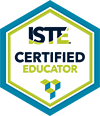Empowering Creative and Critical Thinking with PBL
,
Colorado Convention Center, 107/9
Presenters




Session description
Purpose & objective
Purpose:
The purpose of this session is to introduce educators to the concept of Project Based Learning (PBL) as a transformative approach to education. It aims to demonstrate how PBL can empower students to develop their creative and critical thinking skills across various subjects. The session also provides practical guidance on initiating and implementing PBL in the classroom. By sharing ready-made activities that emphasize student voice and choice, the session encourages educators to foster a sense of ownership of learning among their students.
Objectives:
Introduction to PBL: Provide an overview of Project Based Learning, highlighting its potential to enhance creative and critical thinking skills.
Empowering Learners: Explain how PBL empowers students by giving them autonomy over their learning, fostering curiosity, and promoting self-directed inquiry.
Cross-Curricular Application: Illustrate how PBL can be applied to diverse curricular areas, emphasizing its versatility as an educational strategy.
Getting Started: Offer practical steps and tips for educators to initiate PBL projects in their classrooms, including planning and resource considerations.
Ready-Made Activities: Share a selection of PBL activities that participants can adapt and use in their classrooms, showcasing how these activities promote student voice and choice.
Assessment and Evaluation: Discuss strategies for assessing and evaluating PBL projects, emphasizing the alignment of assessment with learning objectives.
Peer Collaboration: Encourage educators to collaborate with peers and share experiences, resources, and best practices related to PBL implementation.
Outline
Introduction
Why PBL?
Gold Standard PBL Essential Elements
- Challenging Problem or Question: Strategies and Ideas
- Sustained Inquiry: Strategies and Ideas
- Authenticity: Strategies and Ideas
- Student Voice & Choice: Strategies and Ideas
- Reflection: Strategies and Ideas
- Critique and Revision: Strategies and Ideas
- Public Product: Straggles and Ideas
Call to Action - Bring PBL to your Classroom: Collaborative Padlet
Q & A + Closing
Supporting research
Boss, S., & Krauss, J. (2018). Reinventing project-based learning: Your field guide to real-world projects in the digital age, 3rd ed. (Portland, OR: International Society for Technology in Education).
Larmer, J., Mergendoller, J., & Boss, S. (2015). Setting the standard for project based learning: A proven approach to rigorous classroom instruction. (Alexandria, VA: ASCD).
Learn more about shifting your teaching practice in Project Based Teaching: How to Create Rigorous and Engaging Learning Experiences by Suzie Boss with John Larmer (ASCD, 2018).
Gold Standard PBL: Essential Project Design Elements https://www.pblworks.org/what-is-pbl/gold-standard-project-design
Session specifications
Laptop: Chromebook, Mac, PC
Tablet: Android, iOS, Windows
Empowered Learner
- Students articulate and set personal learning goals, develop strategies leveraging technology to achieve them and reflect on the learning process itself to improve learning outcomes.
- Students build knowledge by actively exploring real-world issues and problems, developing ideas and theories and pursuing answers and solutions.
- Students know and use a deliberate design process for generating ideas, testing theories, creating innovative artifacts or solving authentic problems.
| Related exhibitors: | Kami |
 Return
Return Participate and share: Interactive session
Participate and share: Interactive session  Trips and Tours
Trips and Tours Recorded Session
Recorded Session